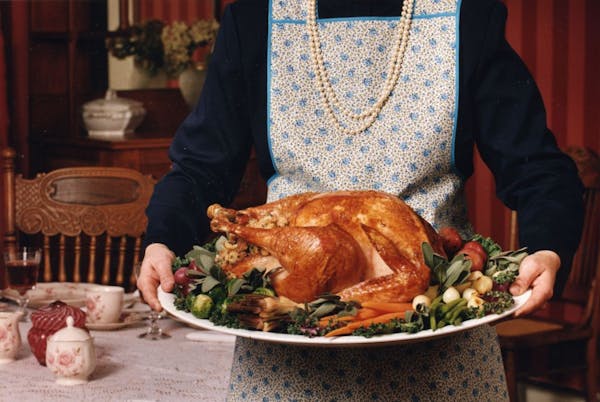Thanksgiving is widely considered a day for turkey.
But because so many of us cook it only once a year -- and then there is a lot of pressure to get it right -- a number of home cooks suffer from a bad case of turkey anxiety.
It needn't be so. Turkey is relatively easy to get right. Short of dropping the cooked bird on the floor or forgetting to remove the plastic bag of giblets (both of which are oft-repeated Thanksgiving horror stories), there are basically only two things that you can get wrong: You can undercook the turkey or overcook it.
Undercooking is easy to fix -- cook it longer. If a meat thermometer inserted into the thigh (without touching the bone) does not read 165 degrees, keep cooking it. Few things are worse than undercooked turkey, including overcooked turkey. Overcooked turkey is just dry, which might be one reason so many people insist on serving it with gravy. It's a way to moisten the meat, just in case.
Thawing the turkey
The most important thing to remember about turkey is, if you buy it frozen, give it plenty of time to thaw. The safest method is to defrost it in the refrigerator, which takes 24 hours for every 4 or 5 pounds of turkey.
If you realize you don't have time to thaw it in the refrigerator, you can defrost it by submerging it completely in cold water, after first making sure it is tightly wrapped so no water gets in the package. It only takes 30 minutes per pound to thaw it this way -- six hours for a 12-pound bird, 10 hours for a 20-pounder -- but the water must be changed every 30 minutes and the turkey must be cooked immediately after it is defrosted. If you don't have enough time to thaw it in water, you can defrost it in a microwave oven by following the appliance's instructions, but keep in mind that many large turkeys will not fit a typical microwave.
Roasting the turkey
Once the turkey has thawed, or if it was bought fresh, the next important consideration is how long to cook it. That depends on the temperature used; some people prefer to begin at 400 degrees or more for the first hour, and then drop it down to 325 degrees. Some keep it at 325 the whole time; never go below that temperature, according to the U.S. Department of Agriculture.
At 325 degrees, figure on about 15 minutes per pound for an unstuffed whole bird up to about 16 pounds (a breast alone will take 25 minutes per pound). A big turkey over 16 pounds has a higher meat-to-bone ratio and will only require 13 minutes or so per pound. The only way to make certain it has been cooked the proper amount of time is to check with a meat thermometer stuck into the thickest part of the thigh without touching the bone. The temperature should read at least 165 degrees.
If you don't have a meat thermometer, the turkey will be cooked when the leg joint moves easily in the socket and the juices run clear when you pierce the skin with a fork.
If you roast the turkey with stuffing inside, it will take significantly longer to reach the right temperature (23 minutes per pound of turkey up to 16 pounds, and 20 minutes per pound for more than 16 pounds). You will need a meat thermometer to make sure the center of the turkey stuffing has reached 165 degrees.
Turkey at rest
As with most meats, the turkey will taste best if you let it rest for 15 to 20 minutes -- or more -- before carving it. You can keep it warm during this period by covering it with a little pup tent of aluminum foil.
The great thing about a turkey dinner is it can be as simple or as complicated as you want to make it. The only flavorings you really need are salt and pepper. If you prefer it just a little fancier, you can make the skin crisper and browner by rubbing it first with softened butter. A sprinkling of paprika over the top will add a subtle, sweetly warm spice, and you can bring even more flavor to the table by putting onions, carrots, celery, garlic and lemon halves in the cavity. It's simple and delicious.
Making the taste a little more complex is just as easy. Sage, rosemary or thyme all go well with turkey -- you can just put herbs in the cavity, too -- but using all three herbs would create too many competing flavors so pick one. Adding a bay leaf or two would be a good move, however.
If you want to get creative, give your bird an Asian flair by brushing it with soy sauce, honey and ginger, or you can give it some Cajun heat with a rub of salt, cayenne pepper, garlic powder, onion powder, paprika, oregano, thyme and black pepper.
Or look to Provence for inspiration, with Dijon mustard, garlic and sage or rosemary.
